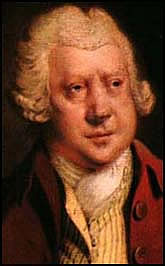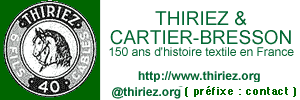| "La filature fut d'abord exécutée manuellement à l'aide d'un fuseau depuis l'antiquité, puis d'un rouet inventé au XVIIème siècle. La filature consiste à étirer et tordre la mèche en fil simple sur un métier à filer. Le fil affiné et tordu est finalement enroulé sur une bobine. Un fil de coton de qualité doit être résistant, élastique et régulier. Les fils peuvent être tissés. Les tissus seront blanchis, teints ou imprimés". | |
 Richard Arkwright |
"La filature est l’art de produire, par des procédés mécaniques, des fils d’une longueur illimitée avec des éléments premiers limités". "Dans l’épaisseur d’un fil de coton, on trouve 100 à 250 fibres, longues de 1 à 3 centimètres. Avec 20 grammes de fibres, on peut fabriquer un fil fin de un kilomètre de long". "Ce n’est qu’à la fin du XVIIème
siècle que le travail du coton devint réellement une
industrie et une source de richesse publique, aussi bien en France
qu’en Angleterre. Les prémices de notre industrie cotonnière, à Lille, Rouen, Amiens et Mulhouse sont de 1795 à 1800. Il est de la plus grande importance de bien savoir choisir le coton en vue de telle ou telle fabrication à obtenir .. la réussite des filatures dépend beaucoup de cette connaissance". |
Process :
|
|
| En 1817, la ville de Lille compte 86 filatures et 100.000 broches; en 1860, l'agglomération Lille-Roubaix-Tourcoing emploie 60.000 ouvriers et compte 800.000 broches à filer et 300.000 broches à retordre, mais une terible disette du coton va mettre à mal cette industrie. Il faudra attendre 1892 pour que la reprise se fasse. | |
"Two types of carding machines
had been developed in the 18th Century. The first, which was originally
invented by Daniel Bourne in 1748 and resembles the modern roller
card, had four revolving cylinders in contact, each faced with carding
wire. The second machine -invented by Lewis Paul -comprised a cylinder
with 20 lengthwise strips of card wire, to engage fixed cards in
a concave hood. This is in fact the basis of today's modern flat
carder used for cotton. On this machine, which was initially hand
driven, the fibre was stripped from the roller with a needle-stick
carrying close rows of projecting teeth. |
|
| "Little is known about Lewis Paul's
early life, but in his book, The History of the Cotton Manufacture
in Great Britain (1835), Edward Baines described him as a "foreigner".
In the 1730s Paul began working in Birmingham with John Wyatt on a
new spinning machine. In 1738 the two men patented a Roller Spinning
machine. This machine had two sets of rollers which travelled at different
speeds. This drew out a sliver of wool to the right thickness before
spinning it. By 1741 this machine, powered by donkeys, was being used in a mill in Birmingham. Soon afterwards Wyatt and Paul went bankrupt. However, five of their machines were purchased by a man called Cave who installed them in his new factory in Northampton. This was the first cotton-spinning mill in history, but the Roller Spinning machine proved to be unreliable, and no one else followed Cave's example. In 1748 Lewis Paul invented a hand driven carding machine. The devise involved a card covered with slips of wire placed round a cylinder. The idea was later developed by other inventors such as Richard Arkwright and Samuel Crompton. Paul and Wyatt continued to try and improve their Roller Spinning machine and a second patent was taken out in 1758. Richard Arkwright later used the machine as a model for his water frame. Lewis Paul died in 1759 Arkwright's Spinning-Frame was too large to be operated by hand and so the men had to find another method of working the machine. After experimenting with horses, it was decided to employ the power of the water-wheel. In 1771 the three men set up a large factory next to the River Derwent in Cromford, Derbyshire. Arkwright's machine now became known as the Water-Frame. He was knighted as Sir Richard Arkwright in 1786, and he died one of the richest men in England." www.spartacus.schoolnet.co.uk |
|
Sources :
- "La Filature du coton, numéros moyens et gros, suivie du travail des déchets et cotons gras", par E. SALADIN, Éditions Léon Deshays Rouen 1885
- sites : www.cvmt.com, www.austehc.unimelb.edu.au, www.spartacus.schoolnet.co.uk, www.cirad.fr, www.quid.fr, www.snv.jussieu.fr
